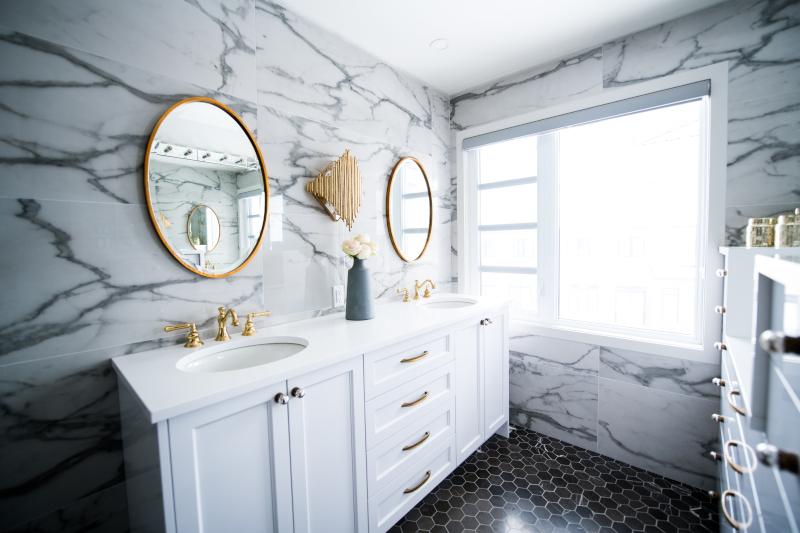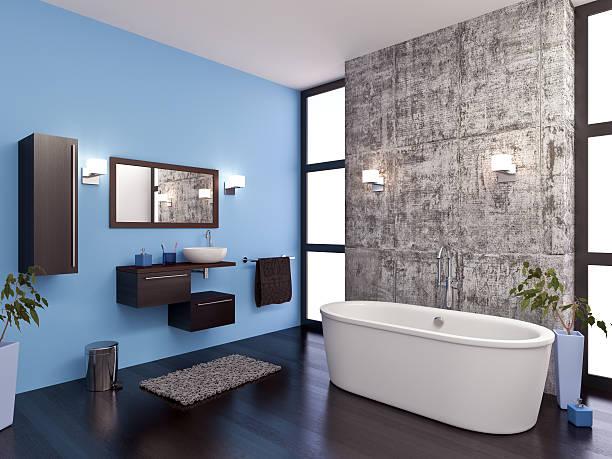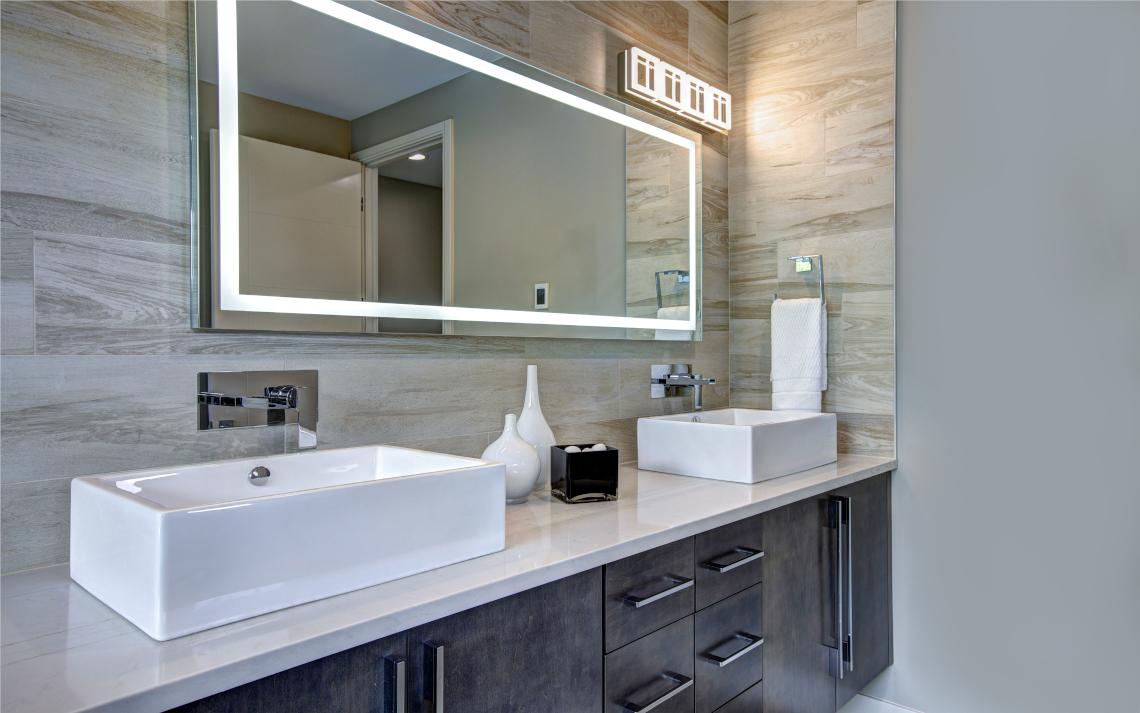Replacing a bathroom vanity is one of the simplest yet most impactful DIY projects you can undertake. Swapping out your old vanity cabinet, countertop, sink, and faucet can dramatically update your bathroom’s look without a complete remodel. Today’s vanities come in a wide range of styles and materials, including quartz and solid surfaces, making it easy to find an option that fits your taste and budget.
Before installing a new vanity, you’ll need to remove the old one. This process involves disconnecting the water supply, removing the drain assembly, and safely detaching the vanity from the wall. Follow this step-by-step guide to complete the project successfully.
Pro Tip Takeaway: Disconnect the sink and countertop from the vanity before cutting the vanity cabinet into parts, if necessary, to make the removal process easier.
Removing a Bathroom Vanity – 8 Easy Steps
Before removing the bathroom vanity, below are the equipment and tools you’ll need during the process as follows:
- Bucket
- Adjustable wrench
- Channel-lock pliers
- Rag
- Tongue and groove pliers
- Utility knife
- Flat pry bar
- Putty knife
- Screw gun
- Woodblock
- Rag
Step 1: Turn Off the Water
Start by turning off the water supply, as you’ll need to disconnect some piping. Look for a valve under the sink dedicated to the vanity unit. If there’s no valve under the bathroom sink, turn off the water at the main shutoff valve, usually located where the main water line enters the house. This could be under the kitchen sink or in the garage.
Turn the shutoff valves counterclockwise to stop the water flow. Open the faucet to let any remaining water drain out, which will also relieve system pressure.
Pro Tip Takeaway: When turning off valves, remember the saying: “Righty tighty, lefty loosey.” Turning clockwise tightens and closes the valve.

Step 2: Disconnect the Water Supply Tubes
Place a bucket under the valves to catch any remaining water. Use an adjustable wrench to loosen the nut on the supply tube connecting the faucet to the shutoff valve. Once loose, slide the supply tubes off the valve.
If you notice water dripping from the valve, turn off the water at the main line.
Pro Tip Takeaway: When installing a new vanity, replace old shutoff valves and supply tubes to avoid future leaks or malfunctions.
Read Also: Best Options for Wheelchair Accessible Bathroom Vanities
Step 3: Remove the Drain P-Trap
The P-trap is the curved pipe located beneath the sink. Loosen the nuts connecting the P-trap to the sink tailpiece and the wall drain inlet. You can often loosen these by hand, but if they’re stuck, use tongue-and-groove pliers. Pull the trap away carefully, as it will likely be full of water.
Empty the trap into a bucket or outside. After removal, place a rag over the open drainpipe to prevent sewer gases from entering your bathroom.
Pro Tip Takeaway: Keep the P-trap in place if you plan to reuse it with the new vanity, but thoroughly clean it to prevent clogs.

Step 4: Remove the Mirror from the Wall
If your vanity mirror rests on the countertop or backsplash, remove it before detaching the vanity. Removing the mirror prevents accidental breakage during the cabinet removal. If the mirror is glued to the wall, it’s best to leave it unless you plan to replace it.
Step 5: Cut the Caulk Joints
Use a utility knife to cut through the caulk joints where the vanity top meets the wall and at all seams between the countertop and the cabinet. Be sure to cut through any caulk where the cabinet meets the wall as well.
Pro Tip Takeaway: Use a sharp utility knife to make clean cuts through the caulk, which makes detachment easier.
Step 6: Remove the Vanity Top
Look inside the cabinet for screws securing the countertop to the vanity. If there are no visible screws, the top may be glued down. Insert a putty knife between the countertop and cabinet frame to break the sealant bond.
After loosening the adhesive, pry the top off carefully with a flat pry bar. Get help from an assistant if the top is heavy. Lay it flat with the faucet hanging over the edge for easy removal later.
Pro Tip Takeaway: If the vanity top is glued down tightly, use a putty knife and tap gently with a hammer to loosen it without damaging the cabinet frame.
Step 7: Remove the Vanity Cabinet
Check inside the cabinet to see how it’s mounted to the wall. Most vanities are secured with screws driven through a mounting strip into the wall studs. Use a drill or screwdriver to remove these screws.
If the cabinet is nailed to the wall, use a flat pry bar to carefully separate it. Place a woodblock between the pry bar and the wall to prevent damage.
Pro Tip Takeaway: Move the cabinet carefully to avoid damaging the plumbing valves and pipes.

Step 8: Finish the Project
Once the vanity is removed, scrape away any remaining caulk or adhesive from the wall with a putty knife. If your new vanity is smaller or shorter than the old one, plan to patch and paint the wall or floor before installation.
Pro Tip Takeaway: Take this opportunity to upgrade flooring, repaint walls, or fix any damage to achieve a fresh look before installing your new vanity.
Ready to Remove Your Bathroom Vanity?
That’s all there is to it when it comes to removing a bathroom vanity! We hope this guide has inspired you to tackle the project yourself or hire a professional if needed. If you’re in Houston, Texas, and want expert help, Smart Remodeling LLC is here for you.
Smart Remodeling LLC is your trusted partner for bathroom renovation projects. Whether you need to remove an old vanity or install a new one, our team is ready to provide high-quality service and stunning results. Contact us today to get started on your bathroom transformation!






